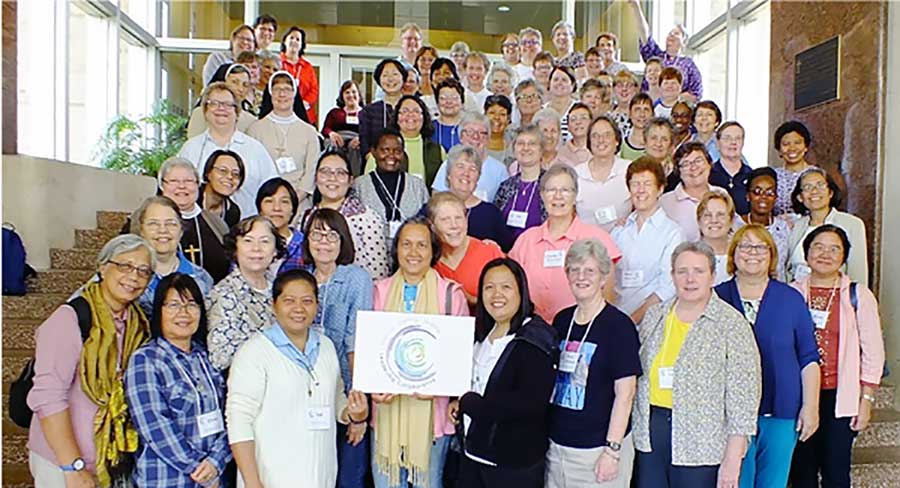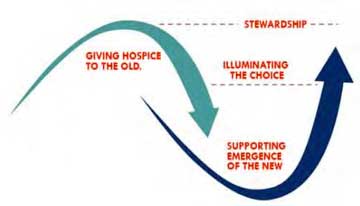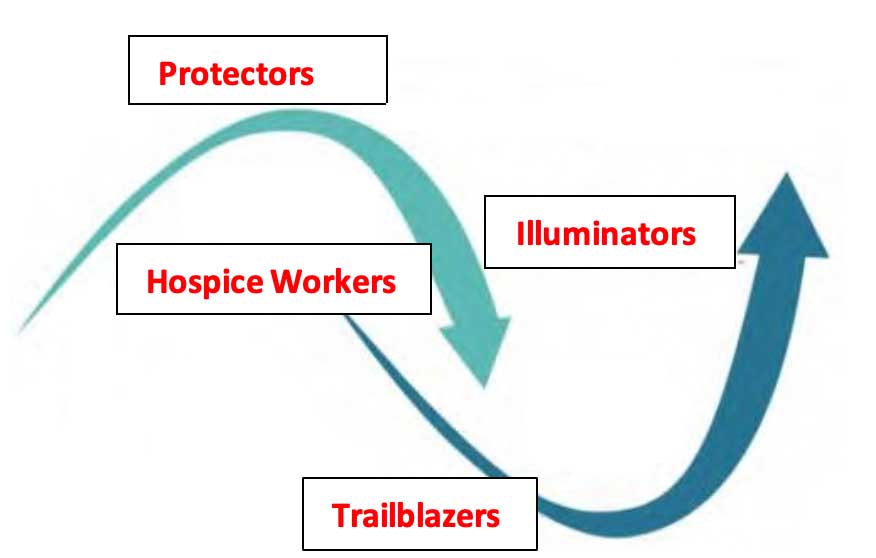The Leadership Collaborative: Offering a Way Forward
Posted on September 1, 2019, by Lisa Reynolds CoL

Photo courtesy of Lisa Reynolds
As a participant in LCWR’s Collaborative Leadership Development Program (CLDP) in 2013-2014, I recently was invited to attend this year’s Leadership Collaborative Biennial Conference in Chicago as a participant on a panel. The Leadership Collaborative (LC) was created to support the vowed, associates and co-members who had completed CLDP. It was designed, in the words of LC Executive Director Vicki Wuolle CSA to “seek greater sustainability in offering leadership development, networking and visioning for the future.” This year’s gathering May 30-June 2 had 80 participants from 27 different congregations and seven countries.
Prior to our gathering, we were asked to read a summary paper by Linda Buck CSJ entitled, “Leaders in a Diaspora Moment.” The concepts presented in the paper were so insightful and inspiring, I wanted to share some of them with you here.
A ‘Diaspora Moment’
Sister Linda describes this point in time for religious communities: “Since the Second Vatican Council, rapid changes have created tension between a Spirit-led vision that is still being lived into and the grief of what was and what will never become. This tension holds great potential, if we continue to bring it into consciousness.” Thus she describes this “Diaspora moment”:
The ramifications of the destruction of the Temple for the Jewish people parallel what is happening for women religious today. We all have to let go of what we thought it should be like and how we saw ourselves in this life. We cannot go back to how it was because that simply does not exist anymore. There is a lure to search for a new home; we experience the tension of maintaining our identity and culture with that which was known as well or altering it to meet that which is unknown and emergent.
A ‘Collective Awakening’ and ‘Reactive’ Response
Many of us outside of religious life are experiencing something similar. Long-held assumptions about personal and cultural identity no longer hold the immutability they once did. We’re recognizing not only the limits of traditional social, political and economic systems based on dominance and individualization to provide a supportive and thriving life on Earth, but also the harm these systems are causing. There is a collective awakening recognizing our interconnectedness with all of creation. At the same time, we’re witnessing a “reactive” response to this shift. Behaviors and belief systems that are self-limiting and work to protect one’s ego needs through control, manipulation or even anger, judgment and violence are increasing as the deconstruction of those systems threaten identities dependent on them.
‘Holding the Tension’
Our temptation to resolve this challenging condition, to move beyond it and out of the tension inherent in it is compelling; our inclination to criticize the “other” as at fault for the situation is pervasive. Yet “holding the tension” is sage advice for how to stand with the reality of both the ending of what is familiar and the emerging but unknown future.
How do we “hold the tension”? What can help us understand this liminal moment and can support us in knowing our role in it?
The Two-Loop Theory and the 360° Leadership Tool
The conference offered two important models that we might find useful, the Two-Loop Theory and the 360° Leadership Tool.

The Two-Loop Theory is based on a model created by Margaret Wheatley and Deborah Frieze a few years ago. Based on the work of Wheatley and Frieze, the two-loop model explains the dynamic of collapse and birth as a normal life cycle for systems. They summarize, “As one system culminates and starts to collapse, isolated alternatives slowly begin to arise and give way to the new.” This model offers a visual way to conceptualize the change we are experiencing, perhaps even unconsciously, that without a greater context can feel threatening or despairing.
In addition to providing a model of the dynamics of this changing system, Frieze offers four roles to “name the tasks at hand … Regardless of the trajectory — the upper arc or the low arc — we are all ‘wayfinders,’ called to see the unseen horizon and have a role in birthing the future. The four roles highlight a framework for the undertakings needed in order to allow for this emergent life” (Buck, 2019).
Illuminator
Illuminators are the story tellers that articulate the efforts of those that are forging into new territory. They hold our collective memory and hope. In the midst of resistance and criticism, they repeat the story, ensuring it continues to live in the present.
Protector
Protectors work within the existing systems to nurture transformation within dominant structures. They generally hold positions within the dominant system and are quiet revolutionaries. … It is the Protector which allows for the work to find root within the dominant structure.
Hospice Worker
Hospice workers bring comfort to those in transition – passing from one life to another. They advocate for the needs brought about by this transition. They offer compassion and support to those suffering in the transition – and they are reminders of hope for what may emerge.
Trailblazer
Trailblazers can be thought of as pioneers, forging ahead to create a new future. They free themselves of the constraints of the system, take risks and develop new networks that inform the emergent. These trailblazers are really partner-builders, desiring to connect with others because they know that they alone cannot realize the dream.
(Excerpted from Linda Buck CSL, 2019)
I find that this model not only describes where many of us, whether religious communities, political bodies, nations, organizations, families or individuals, are finding ourselves, but most importantly, it offers a model that values our various expressions of spirit for the essential part they play in supporting a greater transformation. Rather than succumbing to the more-than-familiar dualism of “who’s right and wrong” that is a reflection of the traditional patriarchal model we’ve known, we can recognize the value of the different gifts and approaches each of us can bring to this dynamic and challenging situation.
The second model, the 360° Leadership Tool, is based on the Leadership Circle, founded by Bob Anderson. Each of the CLDP attendees completed the 360° profile, and it provided helpful insights into our “creative competencies” and “reactive tendencies” that can impact effective leadership. Creative competencies, characteristics that include qualities such as compassion, community concern and systems thinker, support the psychological, emotional and spiritual skills and gifts especially needed for this “diaspora” moment. Our reactive tendencies, such as passive, critical or autocratic, can serve to maintain the ineffective but familiar systems that limit our way forward.

Using the 360° Leadership Tool in conjunction with the Two-Loop Theory, we can use our creative competencies to carry out the four roles in which we can best serve.
Living in Ways that a Deeper Calling Envisions
As people grounded in a deep spirituality, we are blessed with an awareness of a reality unlimited and undefined by the structures and systems in which we find ourselves. Tools such as the Two-Loop Theory and 360° Leadership Tool can help us manifest that reality as we experience transformation of both our individual selves and the world in which we live. As people informed by Spirit, we are called to live in ways that model an alternative community, spirituality and mission that a deeper calling envisions. As we learned in LCWR’s “However Long the Night,” in the words of Krista Clements Orlan MA, FSPA Affiliate, ongoing leadership development director, “Women religious are called to be models of radical acceptance and courageous vision as we move into the future. … Our courage in responding creatively to reality will be an inspiration to others during these difficult and often chaotic times.”
